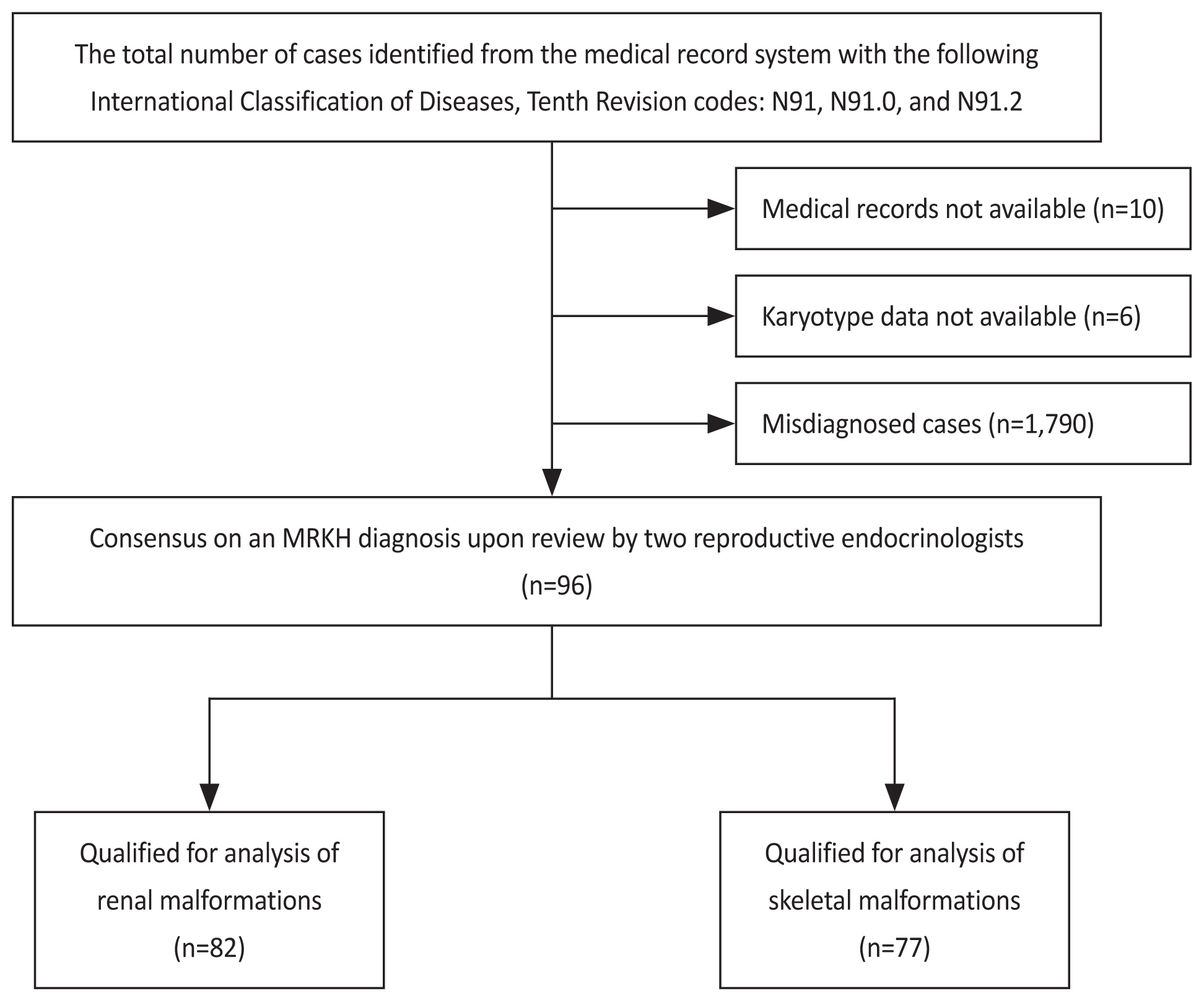Obstet Gynecol Sci.
2024 May;67(3):314-322. 10.5468/ogs.23211.
Clinical features and management of women with Mayer-Rokitansky-Küster-Hauser syndrome in a Thai population
- Affiliations
-
- 1Department of Obstetrics and Gynaecology, Faculty of Medicine, Prince of Songkla University, Songkhla, Thailand
- KMID: 2555515
- DOI: http://doi.org/10.5468/ogs.23211
Abstract
Objective
This study aimed to describe the clinical features, associated extragenital anomalies, and management of Mayer- Rokitansky-Küster-Hauser (MRKH) syndrome in a Thai population.
Methods
This retrospective study analyzed the medical records of 96 patients with MRKH syndrome diagnosed and treated at a university hospital and tertiary referral center in southern Thailand between 2000 and 2022.
Results
The study included 96 patients with MRKH syndrome. The most common symptom was primary amenorrhea (88.5%), followed by difficulty or inability to engage in sexual intercourse (9.4%) and pelvic mass (2.1%). Notably, 80.3% of the patients did not have extragenital malformations and were diagnosed with MRKH type I (typical form), whereas 19.7% were categorized as MRKH type II (atypical form). Skeletal malformations were the most frequent extragenital anomalies and were present in 19.5% of patients, with scoliosis being the most common skeletal condition. Other extragenital malformations included renal (8.5%) and neurological (1.0%) abnormalities. Clinical vaginal examination revealed complete atresia in 21.8% and vaginal hypoplasia (median vaginal length, 3 cm) in 78.2% of the patients. Half of the patients did not receive treatment because they had not engaged in sexual intercourse. In this cohort, 41.7% of the patients had no difficulty performing sexual intercourse. Hence, self-dilation therapy or concomitant dilation was recommended. Only eight patients (8.3%) underwent surgical reconstruction of the vagina.
Conclusion
This study confirmed the complexity and heterogeneity of the phenotypic manifestations of MRKH, including the degree of vaginal atresia and types and rates of associated malformations.
Figure
Reference
-
References
1. Choussein S, Nasioudis D, Schizas D, Economopoulos KP. Mullerian dysgenesis: a critical review of the literature. Arch Gynecol Obstet. 2017; 295:1369–81.
Article2. Aittomäki K, Eroila H, Kajanoja P. A population-based study of the incidence of Müllerian aplasia in Finland. Fertil Steril. 2001; 76:624–5.
Article3. Timmreck LS, Reindollar RH. Contemporary issues in primary amenorrhea. Obstet Gynecol Clin North Am. 2003; 30:287–302.
Article4. Herlin MK, Petersen MB, Brännström M. Mayer-Rokitansky-Küster-Hauser (MRKH) syndrome: a comprehensive update. Orphanet J Rare Dis. 2020; 15:214.
Article5. Acién P, Acién M. The presentation and management of complex female genital malformations. Hum Reprod Update. 2016; 22:48–69.
Article6. Herlin M, Bjørn AM, Rasmussen M, Trolle B, Petersen MB. Prevalence and patient characteristics of Mayer-Rokitansky-Küster-Hauser syndrome: a nationwide registry-based study. Hum Reprod. 2016; 31:2384–90.
Article7. Committee on Adolescent Health Care. ACOG committee opinion no. 728: Müllerian agenesis: diagnosis, management, and treatment. Obstet Gynecol. 2018; 131:e35–42.8. Preibsch H, Rall K, Wietek BM, Brucker SY, Staebler A, Claussen CD, et al. Clinical value of magnetic resonance imaging in patients with Mayer-Rokitansky-Küster-Hauser (MRKH) syndrome: diagnosis of associated malformations, uterine rudiments and intrauterine endometrium. Eur Radiol. 2014; 24:1621–7.
Article9. Patterson CJ, Crawford R, Jahoda A. Exploring the psychological syndrome on young women: an interpretative phenomenological analysis. J Health Psychol. 2016; 21:1228–40.
Article10. Ernst ME, Sandberg DE, Keegan C, Quint EH, Lossie AC, Yashar BM. The lived experience of MRKH: sharing health information with peers. J Pediatr Adolesc Gynecol. 2016; 29:154–8.
Article11. Creatsas G, Deligeoroglou E, Christopoulos P. Creation of a neovagina after Creatsas modification of Williams vaginoplasty for the treatment of 200 patients with Mayer-Rokitansky-Kuster-Hauser syndrome. Fertil Steril. 2010; 94:1848–52.
Article12. Oppelt PG, Lermann J, Strick R, Dittrich R, Strissel P, Rettig I, et al. Malformations in a cohort of 284 women with Mayer-Rokitansky-Küster-Hauser syndrome (MRKH). Reprod Biol Endocrinol. 2012; 10:57.
Article13. Rall K, Eisenbeis S, Henninger V, Henes M, Wallwiener D, Bonin M, et al. Typical and atypical associated findings in a group of 346 patients with Mayer-Rokitansky-Kuester-Hauser syndrome. J Pediatr Adolesc Gynecol. 2015; 28:362–8.
Article14. Lalatta F, Motta F, Restelli E, Bellini M, Miozzo M, Gervasini C, et al. Dysmorphologic assessment in 115 Mayer-Rokitansky-Küster-Hauser patients. Clin Dysmorphol. 2015; 24:95–101.
Article15. Kapczuk K, Iwaniec K, Friebe Z, Kędzia W. Congenital malformations and other comorbidities in 125 women with Mayer-Rokitansky-Küster-Hauser syndrome. Eur J Obstet Gynecol Reprod Biol. 2016; 207:45–9.
Article16. Pan HX, Luo GN. Phenotypic and clinical aspects of Mayer-Rokitansky-Küster-Hauser syndrome in a Chinese population: an analysis of 594 patients. Fertil Steril. 2016; 106:1190–4.
Article17. Deng S, He Y, Chen N, Zhu L. Spectrum of type I and type II syndromes and associated malformations in Chinese patients with Mayer-Rokitansky-Küster-Hauser syndrome: a retrospective analysis of 274 cases. J Pediatr Adolesc Gynecol. 2019; 32:284–7.
Article18. Kulkarni MM, Deshmukh SD, Hol K, Nene N. A rare case of Mayer-Rokitansky-Kuster-Hauser syndrome with multiple leiomyomas in hypoplastic uterus. J Hum Reprod Sci. 2015; 8:242–4.
Article19. Blontzos N, Iavazzo C, Vorgias G, Kalinoglou N. Leiomyoma development in Mayer-Rokitansky-Küster-Hauser syndrome: a case report and a narrative review of the literature. Obstet Gynecol Sci. 2019; 62:294–7.
Article20. Wang Y, Lu J, Zhu L, Chen R, Jiang B, Hou B, et al. Increased incidence of abnormally located ovary in patients with Mayer-Rokitansky-Küster-Hauser syndrome: a retrospective analysis with magnetic resonance imaging. Abdom Radiol (NY). 2018; 43:3142–6.
Article21. Wang Y, He YL, Yuan L, Yu JC, Xue HD, Jin ZY. Typical and atypical pelvic MRI characteristics of Mayer-Rokitansky-Küster-Hauser syndrome: a comprehensive analysis of 201 patients. Eur Radiol. 2020; 30:4014–22.
Article22. Marsh CA, Will MA, Smorgick N, Quint EH, Hussain H, Smith YR. Uterine remnants and pelvic pain in females with Mayer-Rokitansky-Küster-Hauser syndrome. J Pediatr Adolesc Gynecol. 2013; 26:199–202.
Article23. Ledig S, Wieacker P. Clinical and genetic aspects of Mayer-Rokitansky-Küster-Hauser syndrome. Med Genet. 2018; 30:3–11.
Article
- Full Text Links
- Actions
-
Cited
- CITED
-
- Close
- Share
- Similar articles
-
- A Case of Uterine Leiomyomas in both Rudimentary Uterine Horns in a Woman with the Mayer-Rokitansky-Kuster-Hauser Syndrome
- A Case of Mayer-Rokitansky-Kuster-Hauser Syndrome Combined with Single Pelvic Kidney
- A Case of Mayer-Rokitansky-Kuster-Hauser (MRKH) Syndrome with Amenorrhea and Sexual Precosity
- MR Findings of Mayer-Rokitansky-Kuster-Hauser Syndrome: Two Cases Report
- A Successful Surrogate Gestational Pregnancy after IVF-ET in a Patient with Mayer-Rokitansky-Kuster-Hauser Syndrome


